The Bot Implementation Formula with Hans van den Berg
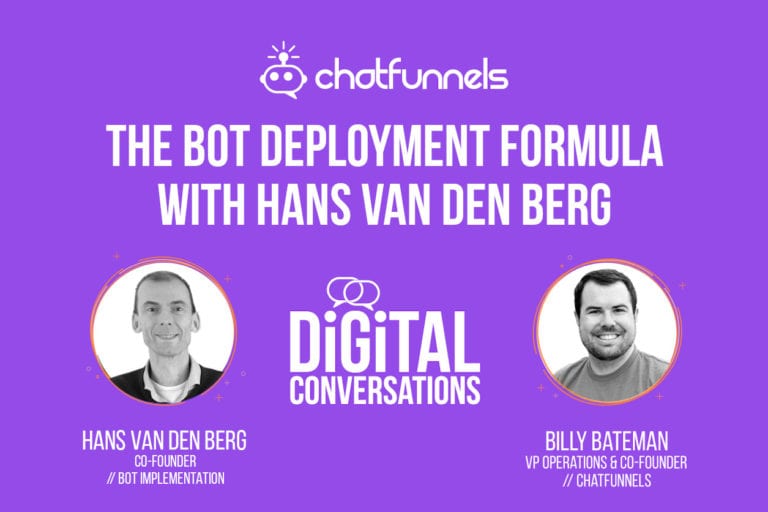
Overview: In this episode we are joined by Hans van den Berg co-founder of Bot Implementation. He presents a formula to create personalized conversation bots. He also lays out some of the most common pit falls that companies fall into when it comes to bot implementation.
Guest: Hans van den Berg- My name is Hans van den Berg, passionate about technology and education I studied at the Technical University in Eindhoven The Netherlands. With my electrical engineering and educational degree I worked at Shell, Philip Morris, hp and Agilent Technologies. For Agilent I was based in the San Francisco Bay Area for 2 years and before I returned to Europe I traveled South East Asia for a year. After my travel I finished my full time MBA specialized in Marketing and Internet at NYIT, USA in 2004. In that year I also launched Izito.com, a search engine that presented search results based on friend’ search activity.
Privileged to co-found SurveyWorld, a true survey SaaS solution, in 1999 with a former room mate I joined what became SyncForce in 2004. In 2018 I got introduced to chatbots and as a personal interest started to dive into the worlds of bots. It seemed to be a perfect link to the needs of our CPG customers at SyncForce as they want to get in contact with their consumers directly. When I was asked by a friend of mine to advise in his Bot startup I couldn’t refuse. I believe this new Bot technology can help brands have great personalized 1on1 conversations in order for them to stay connected and relevant.
Listening Platforms:
Transcription
Billy Bateman: All right everyone, welcome to the show today. Today, I have the pleasure of having Hans Van Den Berg, co-founder Bot implementation joining me. Hans, thanks for joining us
Hans Van Den Berg: Hi, thank you so much Billy for inviting me, much appreciate it, yeah, pretty cool.
Billy: Yeah, excited to have you on. So, before we get going, I want you to just tell everybody a little bit about yourself and about Bar implementation and what you guys do?
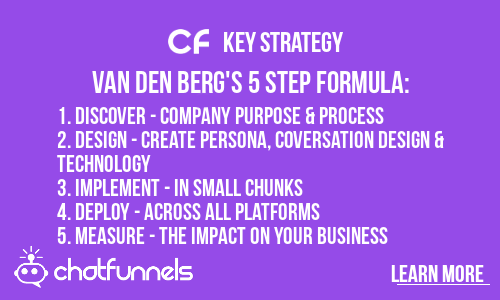
Hans: Cool, yeah so, my name is Hans Van Den Berg and I live in New York. I worked in the b2b software business for almost 25-years, working a lot with manufacturers and as manufacturers these days are a lot talking about—talking directly to their consumers, I was inspired two years ago to dive more into bots and how that could help start one on one conversation, so I did next to my job did a deep dive on all those areas and I caught up with Jerome, again which was starting to look at conversational marketing and I’m more of a technology guy and looking at bots and he’s more in the conversation side, so and he was starting up his own company, so then I he asked me like do you want to join as an advisor and bought implementation and that’s how it all got started and I had a wild dream of having once a podcast and also listening to yours.
So, it was really cool that we did, we started the podcast, so that’s how we rolled into the bots and starting two years ago and now advising and doing and drones and also projects with about implementation, so yeah, really cool exciting stuff that’s going on yeah.
Billy: Okay, man, that is good. So, I asked everybody this, so before we get into it though Hans, I’m going to look you up on social and LinkedIn, Facebook, Instagram, try to figure out who you are what is one thing I wouldn’t figure out by looking at your social profiles?
Hans: Yeah, that’s a cool question but the thing is I’m inspired by the differences in culture because I saw this one coming listening to your podcast. I’m inspired by cultures and I lived for quite some time in the US and also with my thesis Asian stuff, so I really am perplexed about the differences in culture and an interesting mistake perhaps I was doing in education business at HP and I had to go to Japan and the biggest mistake that I made there and that’s the culture thing that I asked the people in Japan at the beginning of the training, of a five-day training program to ask to introduce themselves and that’s of course and definitely not done in Japan.
I’m really perplexed about the differences also living in Belgium coming from the Netherlands the huge differences between Belgium and the Netherlands although they speak the same language, I’m really intrigued about that and I even keep track of all the different wordings between Dutch and Belgium, so yeah, that’s really a big thing for me to always keep an eye on, yeah, which is not on my social media
Billy: Yeah, that’s interesting, that’s interesting man. Okay, and that I’m sure that comes into play with you guys building bots and advising people when you’re building bots for different audiences though
Hans: Absolutely, yeah related to that how you approach people in different culture we always say start a one-on-one conversation and making it personalized, that’s definitely already different in Belgium and the Netherlands and also as you presumably also will see in the US right. So, that’s yeah, how you approach people in real life and of course that’s the same with the bots but that’s so fascinating about the business, yeah absolutely.
Billy: Totally, yeah like you know treat the bot like a person and so too often the first time you build a bot you build it like you’re building a form
Hans: Same thing here, yeah you know
Billy: And that’s the biggest thing it’s like a actually let’s take you know we got to get the information out of this form from somebody but how would we do it if we talked to them like a like a person you know.
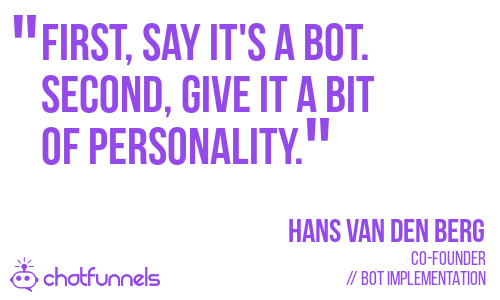
Hans: Right, yeah that’s also one of our that we communicate in our courses and in one of the pitfalls definitely that yeah don’t pretend and the bot is human and definitely and that’s a little bit different but first to say it’s a bot and second give a bit of personality it’s a little bit of a catch 22- but definitely it’s critical yeah, yeah, yeah, so don’t dump an email right into the bot and then think it’s going to convert and start something, cool, absolutely.
Billy: So, let’s circle back to that pitfall, like what do you think are the biggest pitfalls people fall into when they’re trying to build or implement a bot.
Hans: Well, the experience that the room and I have both had is where we find each other’s really that that it’s very tempting to immediately dive into the technology which I did as well when I looked at the bots and how great it is but to do that in a project, I don’t think that is a good thing, so that’s we see a big pitfall you just start and it’s very easy going that when you look at the platforms you can do it but I think that’s not going to be a good one.
I think it’s very critical to at least have a good business purpose and a business goal and at least that you want to look at some what you’re going to solve right if your conversion is low or if people don’t react or if you don’t get a big response or when it’s a long wait and they want to have an instant response in service and that’s a clean business to call why you want to do but yeah people say well I want to but I need a bot and then then we all say why.
Yeah, jump in the technology which is tempting especially for me I did that as well that’s not a good thing, yeah what I just mentioned also pitfall and maybe be real stay it’s Bot and the biggest one also when you have found the business purpose in or the business purpose or what you’re going to solve with a project and that’s also sometimes very difficult with clients but at least when you really doable only and keep asking questions so you get to the nitty-gritty details then chunk it into pieces, right don’t make it a big one so I really like the fact that you make small steps implement that and then go back, measure it and then move to the next one right
Because to do it big thing that’s also a big mistake which I’ve done as well don’t get me wrong but you should do that
Billy: Yeah I agree with you on like it I think we’ve all fallen into let’s build this big bot that can do everything for a client or you know and it never goes well, until you’ve already, maybe when you put together all the pieces and you’ve tested different things you can do that but right off the bat that’s hard.
Hans: So, I know you have a formula that you guys have developed and you teach for implementing bots.
Hans: Right
Billy: Can you can you share some of that formula with us?
Hans: Yeah, yeah sure, yeah absolutely yet the thing is what’s really started based on avoiding the pitfalls, so don’t go out and technology trap make it small so we really have to have the formula where we say okay first determine the why the Allies definitely think like okay for whom are you really doing it and then I mean a person not a system or not a process, so for whom are you going to do it meaning a person that you’re going to talk to and so your prospect you’re we’re talking about also to clients with a patient potentially was ill that you want to start conversations with.
Then have a look for sure at the process, the current process that you have many cases of course use cases we have is regarding the customer journey doesn’t necessarily have to be but look at the process as is and then and when you have the who and then the customer journey which is pretty common but still at some it’s very critical to do first and some people forget, then then look at what goes wrong in the process currently that you want to optimize.
Alright, so we have also a client that is in the B2B that says yeah we engage similar to what we talked about before, you have a form do you want to engage with them and then they say we don’t know enough about them we want to provide them a better offer and we can’t because we don’t know much and we want to increase conversion so then you really have a business case that you want to get to know you prospect better be for example give them an offer that they can’t refuse because it’s so personalized and then you have a clear objective and that’s basically the first step what we say determine the why before you go do anything, right
Billy: Yea
Hans: And when you have that which is some pretty fundamental stuff but I think definitely you should link, take into account what you can do with the bot what you cant, have because when you don’t know what to do with the bot the customer journey is very difficult to optimize. I’m clearly focused on some tips and tricks on in the customer journey what you can do and when you have determined why and that’s more of a what we say in the steps to discovery then you go into the design and not sooner.
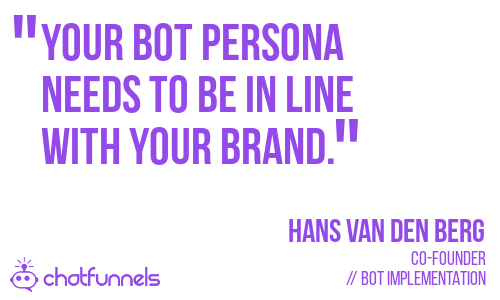
And in the design you have basically three components, you have determined your persona, meaning the persona that you’re going to talk to and of course your bot persona that needs to be in line with your brand and hopefully those two can talk together right, when you yeah it’s talking to somebody that doesn’t agree it’s going to be a nightmare, let’s say we’re dating when there’s no place it’s never going to happen.
And but start with the persona then go into the really high level conversation, design detailed design and what we call micro design and then the terminal to your conversation out score, so really that you that you can measure the conversation out and then go into the technology but that’s the third thing right, when you when your audience is on Facebook and you start with about platform that cannot connect with Facebook and that’s a bummer and in Europe we use a lot of WhatsApp, when they’re not on Facebook and you have a Facebook Messenger but then that’s nice but then you cannot engage with them so pick a platform that definitely serves the needs but Turkey
Billy: Yeah, so you mentioned a conversation health score, how do you how do you do that one here, to check what’s what goes into that?
Hans: Well, what we really focus on is that you say okay you determine the high-level conversations and for example, let’s take an example that we have is that you want to engage with somebody on the website, which is in the web bot of course and you want to engage with them on a certain area where they would across the quote, now when they would of course already click on your bot and want to engage and start the conversation, hey that’s great, and which very simple you can give them points.
Second, if they fill out certain information and they say hey and I talk to them as well, like yeah I need a quote for this product, hey can I advise you for some products, can I give you some IDs or do you know already the product? Now, that’s already sort of a linear choice but perhaps it’s more interesting that you advise them and then ask them some questions on what type of product that what the occasion is for, whom it is for, how many people it is, all that stuff.
Then you advise them and you potentially see that as a more interesting conversation because then you really get a personalized offer for them which of course, in the conversation help and when you talk to somebody you know more about them and of course somebody some people call the beat score but that’s really, I see that’s a good one and it’s sort of a similar model but I think you should really take it to the whole conversation because there are also processes and processes that you want to optimize and start conversations that are not really immediately into converting and so that’s why you named it the conversation help score.
So, you dip the points you make less points and that way you can really see where how engaged and how much you know off of a person so that you can target them more specifically of course and not targeting in nearly an offer but at least if we continue the conversation at the right time with that person.
Yeah, so that’s why we called it conversation health score, yeah does that make sense
Billy: Yeah, it doesn’t make sense, it does make sense, thanks for sharing. So…
Hans: And of course, we train that also that you do that afterwards right first in your conversations and then with some templates we use that to say hey is it is it plus fly for minus all that stuff so it’s pretty basic only for us it was also pretty new when we started
Billy: Yeah, that makes sense. We do a similar thing with our, anytime we launch a new bot for customer you know we go back through usually on a daily basis, see how these conversations are going and have a human look through them and make sure you know not only are people reaching the goals but those that don’t get there, they aren’t doing it because they’re frustrated with the bot that’s just not the right fit for them
Hans: Yeah, absolutely yeah what we also say in the formula is saying okay we have of course the why and the what, but then we also have more of the standard approach from the how, and indeed there are certain phases that you go through with the template so you say okay the first new discovery then we do design then you will implement and then you will test things then you will really deploy and was what you just mentioned is spot-on, then you measure of course the engagement and see where people stop the conversation and I always say through the roam and leave the bar and say I don’t want to talk to you anymore because that’s how we always approach our projects that what would it do in the life situation, yes, that’s what we compare it with
Billy: All right, that’s great man. So, I have a question for you one thing you’ve talked about consistently is going really slow step by step, now whenever you’re implementing the bot, anyone who’s done it from an agency standpoint or even you know you work on a marketing team where you’re in charge of the bot, the boss always wants to go fast and get results right away. How do you how do you manage a customer into taking small steps with when they want to go fast?
Hans: Yeah, great question and the thing is in in our formula and I have experienced that also in the chrome business with implementing software, they want to do a whole lot and of course the pitfall is then it’s too big it takes too long they’re out of budget right that’s what stuff, so indeed you want to avoid that. Now then your question is how do you want to avoid this and how can you for this now in in the start what we do with within the why step so in the discovery, we really determine okay for whom that’s easy.
Now in the process you have the current as this process and the and I just call a process but the current as is customer journey for example we really have a method where you really identify the current problems roadblocks within that process and what we do within that process is, when you list them up and you have five of them right you don’t get to conversion or you don’t get enough information or you don’t get them engaged further up in the fellow you really provide them and that’s the biggest question, what is the impact of that problem now? Now most of the time when you’re in situation what we also both talked about when you’re in the front of the funnel you had a conversion when they don’t even engage with the bots then you should start there, so that’s pretty straightforward.
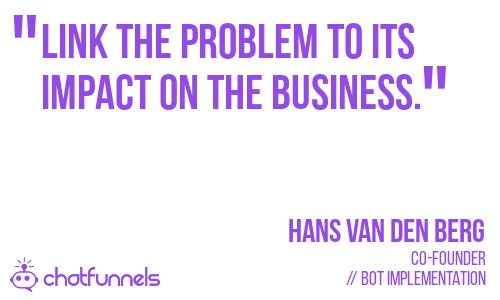
However, if you link the problem to the impact in the business I always let them list only the top five and then they start bugging and saying well we need to do everything and say okay suppose you don’t have any money to do them all, which one is the most important and then they look at me saying why should I do that? Let’s just do it all right, we can easily set up the bot, it’s very quick and it doesn’t cost a whole lot of money because as an agency it’s also very tempting to do it all right, to get the business here but what we then say is no paper your top three and less than there’s one, two, three and they say how we do it well based on the impact on your business.
Now when you have that they really make a conscious decision themselves on what’s the most important thing that I want to solve what will have the biggest impact for them and then you say okay and then you have to be pretty stubborn as being an implementer and saying okay we do that one first and then it’s very tempting to say can we also do the second one and also the third and I always say okay, let’s do the first test it out do that in a week we can still do number two, after a week and a day but we do this once and then we measure then what you always see is then they take the time you have to be stubborn but I’ll have to say really one the one and we pick the one with the biggest impact, so I’m not picking them but they pick it based on the business problem that they want to solve
And that’s always difficult to say yeah it’s very easy to say hey you have to solve a business problem but to find a business problem, that technique and we have the templates for that and tend to really pick the one that you want to start with that’s critical and that’s how we avoid taking the top five
And we always see that when you do the number one you measure it and then you adjust it and you say okay, now it’s stable now we take my number two and it’s always 90% of the time number two is not number two anymore, it became number five and you do that exercise again and then you come in a rhythm where you really go for the impact first and finding the business problem first and then avoid the big banks.
Billy: Yeah that’s a great
Hans: You have to persistent
Billy: Yeah, I know, you have to be persistent and I love that you make them say this is our most important thing and just choose one thing
Hans: Oh yeah as eight seeds very tempting when you know and I do this also with the b2b software, it’s for you know exactly what the pain is at some point
Billy: Yeah, it’s very tempting just be like oh we can do this for you we can do that for you know, we do it all and takes time
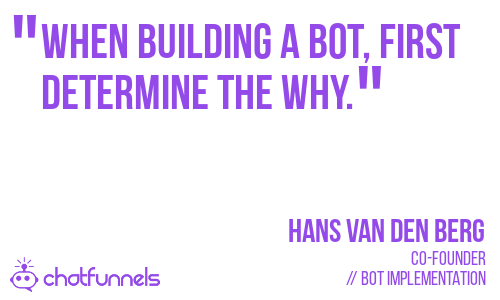
Hans: Yeah and to come up with a roadmap to say oh I would do it like this but then it’s not by choice right and then just getting a little bit tricky. So, I always say do first a discovery, don’t call anything for the bot do first discovery, determine the why and then come up with a quote on what you want to accomplish because there’s on the price in the beginning and then say well you can get a price for the discovery but not a price for the bot yet because we don’t really know what we’re going to do, that’s a little bit and that’s all in the formula and the step by step approach, does that make sense?
Billy: Yes, it does. So, we’re starting to get a little short on time but a few more things I want to hit with you, so one of the things you guys do a lot of work on is creating a bot persona if you have any tips or good examples of doing that?
Hans: Well, it’s of course similar to through to the persona development and probably some people know about it we also have that in a course and in a podcast one episode but the critical thing is of course that you determine really the person that you would see, so you have different canvases for that but what we use definitely is picked the person, name the person, put the age of the person, put the person in where they are at what their situation is etc. that it’s really a real person that it’s really Debra who has two kids and all that sort of stuff and that’s on the side that you need to take into account of who you’re going to target right and some people already do the ladies don’t get me wrong but some people who get into bots, I see that that’s pretty new to them and they forget that and then they dive into technology
And on the other side put your bad persona in and then really and we have a some I think Jerome it’s some nice examples in the only podcast we have some slides for that, then draw the picture of your bot and who will that be right, if that’s is really a masculine guy who is in the gym and you’re targeting you’re going to talk to Debra perhaps that’s not a good match. So, really draw the people and then draw also your but what it needs to be how old it is how it communicates what the languages and then put them next to each other right and then and practice and sit next to each other back-to-back with the conversations and talk will really talk to each other what you have plotted out compare those and then see how it works
Billy: Awesome, and then when you’re designing conversations, do you have any tips on you know where do I start, how do I get going to design a good conversation?
Hans: Well, one tip is definitely start from a high level perspective what and again chunk them down in smaller ones, so you can have a very big what I did wrong in the beginning is that you think oh this is one conversation but then it really trying to chunk that down to two at least five sub and smaller conversations because there did you draw them high level and then pick one, that’s why and that’s also in the process look at the process and only pick one in there as is what is a friction and say okay I’m only going to what you also mentioned right pick the form only that, right and don’t be tempting to be more but only that because that’s the engagement that’s the information that you want to receive so make that small and then do that and then please from a conversation perspective it’s not email it’s also not talking like we do I also talk too much that’s why do realm a lot does the conversation design make it short and sweet that it’s two lines, three lines, within your bot right because about that that’s ten lines that comes along then they will be lost.
So, we also have templates for that to do that and you also have great conversation design software of course that you use well to test it, yeah but small, small, small, small.
Billy: I agree with you on that, shorter is always better on the bot. Then what technologies are you guys using when you implement bots for people?
Well, it’s a good question yeah we talked about the personas and have him the conversations and then the technology, so what we implemented now was mainly the chat bot platforms and mostly linear challenge platform, so I looked at many of them I also have a whole list of a bot ecosystem of all different types like drift what you use an intercom but mostly we now have used many chat because it was a lot impact Messenger and of course jet really have pretty much a lot about active chat as well dived a little bit into to float at AI which is a Dutch player year but they they’re pretty good and also connecting with WhatsApp and I also looked at Momo monkey for example which is also cool platform.
But mainly now as it’s called bot implementation will mainly focus now on chat bots, most of it a linear and with WhatsApp a little linear because WhatsApp doesn’t have such a rich interface and options as messenger of course, yeah so that’s what we’re doing now
Billy: Yeah and then I mean you guys have been building bots for a while, have any funny use cases you guys have been you’ve been tasked with creating
Hans: Well, we haven’t created it and that’s funny but we did review some bots and which I really liked which is not live anymore but was really cool, was actually there while you mentioned it to Jamie Oliver bot where the thing was that you can with icons, with emojis of an avocado and a cucumber, you’ve got a recipe and I still find that pretty cool and so when you would put in an lemon or a cucumber and get recipes with that
Billy: That’s fun
Hans: None invoice but it was in emojis, so I found that really-really cool
Billy: Yeah that’s fun but that was not life anymore
Hans: Yea, we changed it, we changed it with Christmas, I don’t know no back again but I think yeah, I have not topped that one I don’t know if it’s even that user-friendly but it was definitely funny
Billy: Yea, definitely fun. Okay before I let you go Hans, if you’re going to give somebody, somebody’s thinking about getting into bots, building a bot for their business, what is your one piece of advice to get started in creating a really good bot for one-on-one conversation?
Hans: First off technology’s tempting but don’t start with that and really find the purpose, the business purpose, what you’re going to fix and doing it and then making small steps because that’s critical
Billy: Okay man, that’s good well if anyone wants to continue the conversation with you, where can they find you?
Hans: www.botimplementation.com that’s the easiest there we have every information podcasts courses and you can contact us as well, so yeah feel free to join the club, yep.
Billy: Okay, awesome. Thank You Hans and we’ll chat later.
Hans: Hey, thanks a lot so much that it was on the podcast. Cheers!
